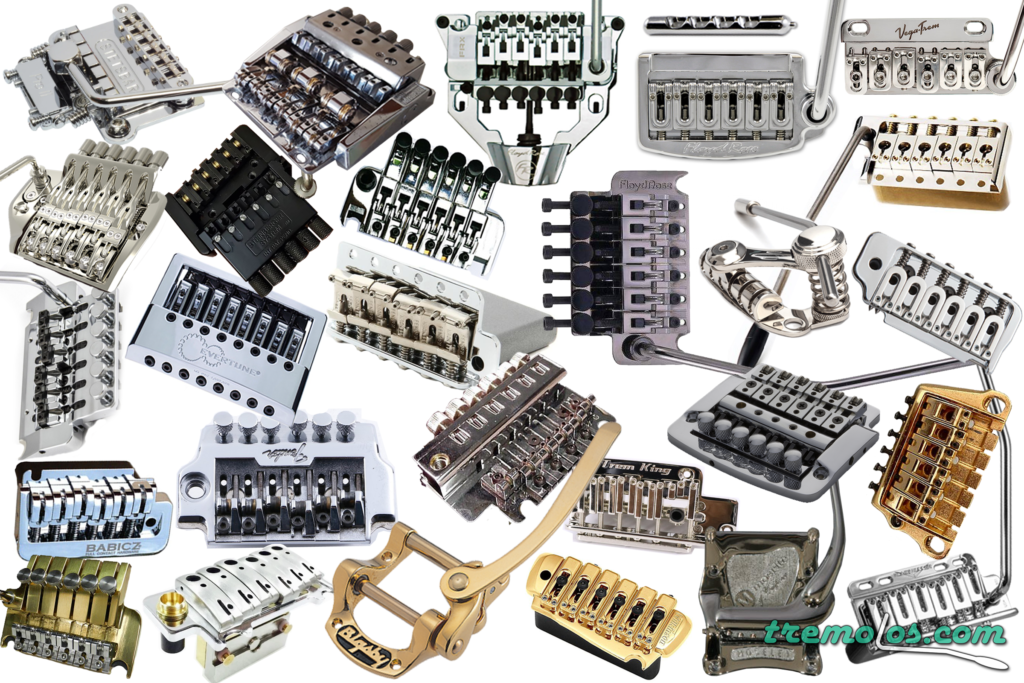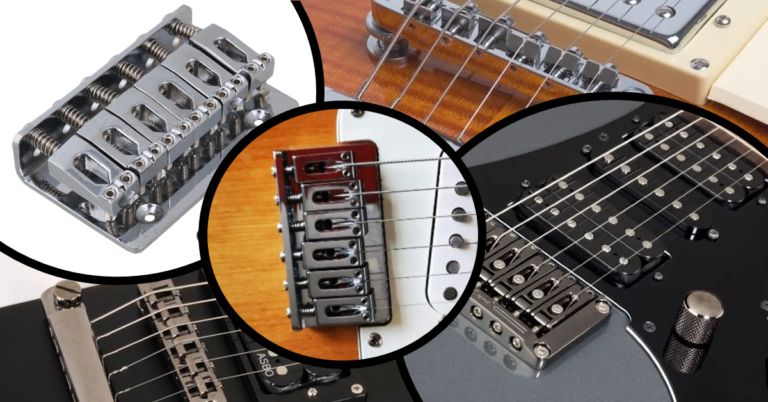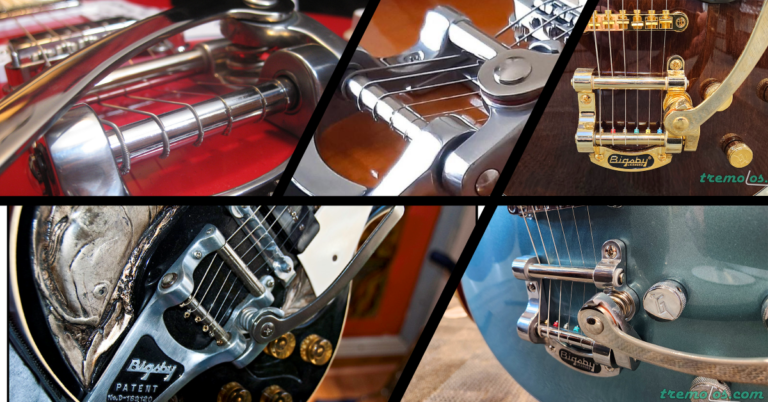Your Ultimate Guide to Tremolos
Welcome to Tremolos.com, your ultimate online destination for everything related to tremolos, vibrato bars, or as many guitarists like to call them, whammy bars. Whether you’re a seasoned guitarist, a dedicated enthusiast, or a complete beginner exploring the expansive world of guitar accessories, Tremolos.com is here to be your go-to resource.
Dive deep into our extensive library (coming soon), where you’ll find a comprehensive collection of resources to help you make the best decision when choosing your next tremolo system. Here, you can compare different brands, styles, prices, and customer reviews, allowing you to make an informed choice based on your specific needs and preferences. Our content includes a variety of tremolo systems and guitar bridge models, each with their own unique characteristics designed to suit different playing styles and genres.
We also offer detailed technical data on various tremolo systems, including vintage-style, locking, floating, and two-point tremolos, so you can explore their features and benefits at a technical level. Whether you’re looking for a model that offers smooth, subtle vibrato or one that provides extreme dive-bomb effects, our site is designed to provide you with everything you need to make an educated decision.
In addition to our comprehensive product comparisons, don’t forget to check out our blog. It’s packed with informative articles, setup tips, maintenance guides, and how-to’s that will help you get the most out of your gear. From step-by-step guides on installing a new tremolo system to troubleshooting tips for tuning stability, we aim to educate and empower guitar players of all levels.
Popular Articles
Do Tremolo Springs Really Make a Difference? A Guide Exploring Their Effect on Performance and Tone.
To clarify the difference between tremolo and vibrato...
tremolo [trem-uh-loh] A wavering effect in a musical tone, typically produced by slight and rapid changes in the volume (amplitude) of a note.
vibrato [vih-brah-to] A rapidly repeated slight change in the pitch (frequency) of a musical note.
While we acknowledge that the correct term for this device is “vibrato,” the misnomer coined in the 1950s by pioneer Leo Fender has developed a distinct identity of its own over time!
Explore A Tale on Tailpieces for a deeper dive into the history of the tremolo.
Guitar Tremolos: A Rich History of Innovation and Evolution
The tremolo system has long been a defining feature of the electric guitar, allowing players to manipulate pitch with a dynamic and expressive effect. Interestingly, the term “tremolo” is often misunderstood. In the world of guitars, the term refers to what is technically a vibrato bar or whammy bar—a device that alters the pitch of the strings, creating a wavering or bending sound. This contrasts with the actual tremolo effect, which modulates volume. Despite this common misapplication, the term “tremolo” has become synonymous with pitch modulation in the guitar world, and it’s this misnomer that has helped shape the evolution of this iconic tool.
The Origins of the Guitar Tremolo
The story of the guitar tremolo can be traced back to the early 20th century. While the basic concept of a pitch-modulating device existed long before, one of the earliest commercially successful designs came in the form of the Kauffman Vibrola, introduced by Doc Kauffman in the 1930s. This early version laid the foundation for future developments, though it wasn’t until the 1950s that the tremolo system gained widespread popularity.
During the mid-20th century, guitar manufacturers such as Fender and Bigsby revolutionized the tremolo system by introducing designs that were not only more practical but also highly reliable. These innovations led to the whammy bar becoming an integral component in electric guitar design, one that would go on to shape the sounds of rock, blues, and countless other genres for decades.
Key Figures and Groundbreaking Innovations
Doc Kauffman
Doc Kauffman is considered one of the pioneers of guitar hardware. His early work on the Kauffman Vibrola system in the 1930s helped lay the groundwork for later innovations in tremolo and vibrato systems, though it was just the beginning of what would become a much broader movement in guitar design.
Leo Fender
In the 1950s, Leo Fender and his team at Fender Guitars took the tremolo system to new heights with the Synchronized Tremolo system, introduced alongside the iconic Fender Stratocaster. This system allowed for smooth pitch bending via a whammy bar and became one of the most iconic and widely used designs in electric guitar history. The Stratocaster, with its Synchronized Tremolo, remains a hallmark of modern guitar design to this day.
Paul Bigsby
Paul Bigsby, an influential figure in the early years of guitar hardware, introduced the Bigsby Vibrato in the 1940s. This design became one of the first widely adopted tremolo systems and continues to be a key feature on many hollow-body guitars. The Bigsby system is renowned for its subtle pitch modulation and smooth, vintage feel, making it a favorite among guitarists who appreciate a more delicate tremolo effect.
Floyd Rose
The Floyd Rose Locking Tremolo introduced in the late 1970s was a game-changer in the world of tremolos. Designed specifically to keep guitars in perfect tune even after aggressive whammy bar use, the Floyd Rose system became the go-to choice for heavy metal and hard rock players. The Floyd Rose system allows for extreme pitch bends and dive bombs while offering exceptional tuning stability, making it an essential tool for musicians who rely on technical playing styles.
Popular Tremolo Systems
Fender Synchronized Tremolo
One of the most iconic tremolo systems, the Fender Synchronized Tremolo, debuted in 1954 alongside the Stratocaster. This system is known for its smooth, expressive pitch bending, allowing guitarists to experiment with subtle vibrato or dramatic pitch shifts. The design has remained a key component of Fender Stratocasters and continues to influence tremolo systems to this day.
Bigsby Vibrato
The Bigsby Vibrato is an enduring classic, known for its subtle, vintage-style pitch modulation. Found primarily on hollow-body guitars like those made by Gretsch, the Bigsby system creates a smooth, shimmering effect that is perfect for genres like rockabilly, blues, and jazz. Its vintage charm and ease of use have made it a favorite among players who prefer a gentle vibrato rather than extreme pitch shifts.
Floyd Rose Locking Tremolo
The Floyd Rose Locking Tremolo is famous for its exceptional tuning stability, even with extreme whammy bar use. Developed in the 1970s, the Floyd Rose system became synonymous with heavy metal and hard rock guitar playing. Its locking mechanism keeps the guitar perfectly in tune despite dramatic bends or dive-bombs, making it the go-to system for guitarists who demand maximum performance and reliability under high-pressure conditions.
Kahler Tremolo
The Kahler Tremolo is unique for its cam-driven design, which offers a more dynamic and adjustable tremolo experience than traditional systems. Unlike the Floyd Rose or Bigsby, the Kahler system allows for a wider range of pitch effects, including extreme pitch shifts and subtle vibrato, all while preserving the guitar’s tonal quality. The Kahler system is highly prized for its versatility, and many players appreciate the level of customization it offers.
Ibanez Edge Tremolo
The Ibanez Edge Tremolo is a high-performance system designed with precision and responsiveness in mind. Favored by shredders and technical guitarists, the Edge tremolo offers exceptional tuning stability, smooth action, and precise pitch bending. It’s a top choice for players looking to push the limits of their instrument’s capabilities.
The Guitarist’s Perspective
Guitarists have long been particular about their choice of tremolo systems, and opinions often vary depending on playing style. For example, Fender tremolos are widely regarded for their classic sound and smooth, organic action, making them a favorite choice for musicians in genres such as blues, rock, and surf music.
On the other hand, Floyd Rose tremolos are revered for their reliability under extreme conditions. Rock and metal guitarists often praise the Floyd Rose for its tuning stability, allowing for aggressive tremolo use without sacrificing performance.
The Bigsby Vibrato is favored by players who appreciate a more subtle, vintage-style vibrato, often described as having a warm shimmer that enhances the tone without drastic pitch shifts. Similarly, Kahler tremolos are loved for their versatility and the ability to produce a wide range of effects, making them ideal for players looking to experiment with different sounds.
Conclusion: The Tremolo’s Enduring Legacy
The tremolo system—whether referred to as a whammy bar, vibrato bar, or simply tremolo—has played an essential role in shaping the sound and evolution of electric guitars for decades. From the subtle pitch modulation of the Bigsby Vibrato to the extreme dive-bombs of the Floyd Rose Locking Tremolo, these systems have allowed guitarists to push the boundaries of their instrument, crafting sounds that were once considered impossible.
Each tremolo system brings something unique to the table, offering musicians a diverse palette of tonal possibilities. Whether you’re after classic smooth vibrato, extreme pitch bends, or rock-solid tuning stability, the tremolo system continues to be a vital tool in a guitarist’s arsenal, enhancing both technique and creativity.
For more in-depth information on tremolos and whammy bars, be sure to check out our detailed guide, A Tale on Tailpieces, where we explore the fascinating world of guitar hardware and its evolution.











